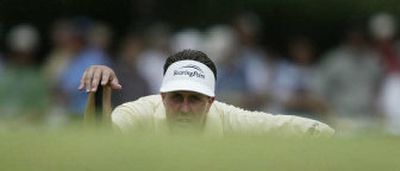Lefty faces hefty task after big 77

PINEHURST, N.C. – Phil Mickelson lobbied all week to make a tough golf course even tougher, stopping just short of daring the U.S. Golf Association to plop down windmills and clown’s-mouth cutouts on the greens.
On Friday, Mother Nature took over the course setup duties from the guys in blue blazers and reminded the left-hander to be careful what you wish for.
“It was very fair,” Mickelson said, carefully choosing his words, “if you played well. You could get off to a quick start, especially the front nine. I didn’t quite do that.
“But,” he said again a moment later, “it was right there if you hit the right shots.”
Suffice it to say that Mickelson didn’t – not off the tees, from the fairways and especially on the greens. He hit just eight of 15 fairways, eight of 18 greens and didn’t make one putt longer than 8 feet. He started on the back nine and made back-to-back bogeys at Nos. 12 and 13, a cruel preview of the four straight Mickelson made to close out his first nine holes.
The 7-over-par 77 scorecard he signed left him eight shots out of the lead at the halfway point. It also marked Mickelson’s worst round at the Open since 1994, when he shot 79 at Oakmont on the final day. It was only his second season as a pro, and back then no one would have imagined that the supremely talented kid with the easy smile was tying the first few knots in a string of major championships failures that would extend to 42 and haunt him for the next 10 years.
The futility ended with a victory in the Masters last year. The rash of mistakes and spectacular collapses became easier to forget, and the times when Mickelson played bravely and well – only to see someone else play better – were easier to remember.
The process was long, painful and often too public. Mickelson vowed to play more aggressively, then less. His convictions changed several times in the course of a single season, and his character got ripped each time. But the fix was relatively simple: better preparations, better decisions and the resolve to see things through. Whether it was the result of frustration or simply maturity hardly mattered.
Either way, that’s what made Friday’s disaster tough to see coming. Mickelson has added both a swing and short-game coach and they do the scouting work before major championships with a military precision that would shame NFL teams during the week leading up to the Super Bowl.
Nine-hour practice rounds became par for the Pinehurst No. 2 course for Team Mickelson. Like everyone else, they knew the inverted, bowl-shaped greens would kick approach shots into some treacherous lies. But they went to the trouble of simulating just about every one. Throw in long stretches on the driving range and practice green, with his coaches, Rick Smith and Dave Pelz, hovering nearby at nearly every moment, and you begin to understand why Mickelson strolled into the interview room on the eve of the Open and invited the USGA professors to get medieval with the final exam.
Mickelson’s opening came when someone asked whether he could imagine the USGA making the same ill-advised setup choice they did for last year’s Open at Shinnecock Hills, where dried-out greens turned some putting surfaces into miniature golf courses from Hell.
“Well, I’m a little biased because I would love to see that happen,” Mickelson said.
“It’s always been my contention that if nobody can hit a green, I’ve got a pretty good chance,” he added. “I’m not opposed to that occurring this week.”
He repeated it a few more times, in a few different appearances. But when he stopped to talk after his second round, all the bravado had been drained out of his face.
There are precious few birdies to be squeezed out of Pinehurst. The course played five strokes above par in the opening round and a slightly less grueling 4-over Friday. The total number of players under par, starting with co-leaders Olin Browne and defending champion Retief Goosen at 2-under, can be counted on one hand.
“You just can’t play aggressive here,” Mickelson said, repeating himself almost as if he had found the mantra. “You just can’t. I think it’s going to take 36 pars to have an outside shot at winning, and that’s kind of what I’m going for.”
The days when Mickelson let one foot get too far in front of the other – only to stumble at the most inopportune moments – were supposed to be a thing of the past.
He might yet thrive in the even-tougher conditions expected through the weekend’s final two rounds.
But at the moment, a bad putting day midway through a tournament that Mickelson said couldn’t be tough enough for his satisfaction has him looking more clownish than just about anything the USGA can do to the greens.